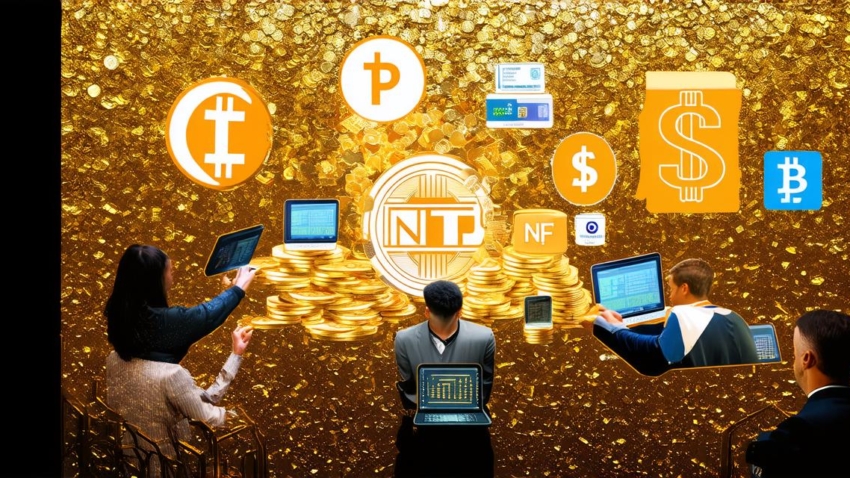
Does an NFT have actual monetary value
What are NFTs?

An NFT is a digital asset that represents ownership of a unique item or piece of content. Unlike traditional cryptocurrencies like Bitcoin and Ethereum, which are interchangeable and can be exchanged for other items of equal value, NFTs are completely unique and cannot be replaced by anything else. This means that each NFT is a one-of-a-kind digital asset that has its own set of attributes and characteristics.
NFTs can represent a wide range of items, from art and music to videos and even tweets. They are created using blockchain technology, which allows for secure and transparent tracking of ownership and authenticity. This makes NFTs an ideal solution for artists and creators who want to monetize their work in a new and innovative way.
Applications of NFTs
One of the most popular applications of NFTs is in the art world. Artists can use NFTs to represent their creations as unique digital assets that can be bought, sold and traded on blockchain-based marketplaces. This allows for a new level of transparency and authenticity in the art world, as buyers can be sure that they are purchasing an original work of art that has been verified by the artist themselves.
Another application of NFTs is in the music industry. Musicians can use NFTs to represent their music as unique digital assets that can be sold and traded on blockchain-based platforms. This allows for a new level of control and ownership over their work, as well as the ability to monetize it in a more direct and efficient way.
NFTs also have potential applications in the gaming industry, where they can represent unique in-game items or collectibles that can be traded and used within games. This allows for a new level of engagement and ownership within the gaming community, as well as the ability to monetize game assets in a more direct and efficient way.
Factors That Determine NFT Value
1. Rarity
One of the most important factors that determine the value of an NFT is its rarity. The more unique and one-of-a-kind an NFT is, the higher its value will be. For example, a rare artwork created by a famous artist may fetch a much higher price than a more common piece of art.
2. Authenticity
Another important factor that determines the value of an NFT is its authenticity. NFTs are only valuable if they can be proven to be unique and original, as opposed to being fake or counterfeit. This requires a high level of transparency and security, which is provided by blockchain technology.
3. Demand
The demand for an NFT also plays a role in determining its value. If there is a high demand for a particular NFT, its value will be higher than if it were less popular. This can be influenced by factors such as the popularity of the creator or the subject matter of the NFT.
4. Utility
Finally, the utility of an NFT also determines its value. If an NFT has a practical use or application, such as being used within a game or providing access to exclusive content, its value will be higher than if it were purely decorative.
Real-Life Examples of NFT Value
There are many real-life examples of NFTs that have fetched high prices and demonstrated their value in the marketplace. One notable example is the “Everydays: The First 5000 Days” artwork by Beeple, which was sold as an NFT for a record-breaking $69 million at Christie’s auction house in 2021.
Another example is the rare “CryptoKitties” collectible, which was sold for over $140,000 in 2017. This demonstrates the high potential for NFTs to represent valuable and unique items in a variety of industries.
FAQs
Q: What are NFTs?
A Non-Fungible Token (NFT) is a digital asset that represents ownership of a unique item or piece of content. Unlike traditional cryptocurrencies, NFTs are completely unique and cannot be replaced by anything else.
Q: How do NFTs determine their value?
The value of an NFT is determined by several factors, including rarity, authenticity, demand, and utility.
Q: What are some real-life examples of NFTs with high values?
One notable example is the “Everydays: The First 5000 Days” artwork by Beeple, which was sold as an NFT for a record-breaking $69 million at Christie’s auction house in 2021. Another example is the rare “CryptoKitties” collectible, which was sold for over $140,000 in 2017.
Q: Can NFTs be used in industries other than art and music?
Yes, NFTs have potential applications in a variety of industries, including gaming, sports, and even real estate.
Summary
In conclusion, NFTs are a new and innovative form of digital asset that has the potential to represent unique and valuable items in a variety of industries. While there is still debate about whether NFTs actually have any real monetary value, their rarity, authenticity, demand, and utility all contribute to their potential worth. As the blockchain technology underlying NFTs continues to evolve, we can expect to see even more creative and innovative uses for these digital assets in the future.







